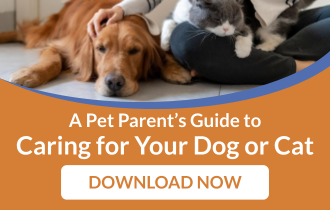We love our pets, and it’s terrible to see them hurting because they’ve accidentally gotten into (eaten or lapped up) something that harms them.
It’s not as easy as you think to keep hazardous stuff away from pets. Accidental spills, dropped pills, yummy smelling stuff on the counter, and even lovely flower bouquets or houseplants can make dogs and cats very sick.
The ASPCA’s Animal Poison Control Center received more than 370,000 calls from pet parents about pet poisoning in 2020 alone! Most of these poisonings are avoidable if you know what to watch out for.
What are the most common causes of pet poisoning?
Pet Poisons in Your Home
Just like you’d keep your home safe for young children, you’d do the same kinds of things for your pets. Many poisonous items can cause a variety of symptoms in pets, such as vomiting, diarrhea, acting funny, or even death. So better safe than sorry, and keep dangerous things out of their reach. It’ll save you an unexpected trip to your vet’s office and save you the expense.
The Animal Poison Control Center breaks down the number of pet poisoning calls in 2018 to give us an idea of the scope of the problem listed by item. Here’s a list of the top dangers based on where they may likely be found in someone’s home.
1. Attics, closets, and other areas of concern
These are the areas where certain pests might live in your home—attics, closets, and other out-of-the-way places. Pests like moths and other insects, rats, or mice are unwanted guests in our homes. To get rid of these pests, people will use mothballs, insecticides (they kill insects), and rodenticides (they kill rats and mice). Keep pets away from areas where these substances are stored or used in your home.
Also, many people keep cleaning products and batteries in closets, so make sure your pet can’t get into these closets.
2. Bathrooms and bedrooms
There are many things that we use for our daily personal care needs that are poisonous to pets. These include medications (over-the-counter or prescription), “recreational” drugs, supplements, vitamins, garbage, cleaning products, personal care products, and cosmetics. Keep them off your bedside table, your bathroom sink, or counter. Put them inside a cabinet or closet —keep the doors shut—so that your pet won’t find them.
If you smoke in your home (I’m sure you know that it’s not recommended), keep those items away from pets. This includes tobacco products, like cigarettes and cigars, as well as “recreational” drugs and medical marijuana (THC and CBD).
3. Kitchen
A kitchen is a place many pets love. Toxic things you may have include garbage, toxic foods (grapes, chocolate, etc.), alcohol, medications, and cleaning products. Keep these items stored safely out of reach in cabinets or closets that pets can’t open.
4. Junk drawer
If you’re like me, you may have a drawer filled with a variety of odds and ends that you named “The Junk Drawer.” Many people will have poisonous items like batteries (used or new), as well as small items that are harmful to your pet in this place, so keep that drawer closed.
5. Living room
You may want to have a nice-smelling living room. Unfortunately, some kinds of fragrances that are pleasant for people can be toxic for your pet. Febreze is reported to be safe to use. Keep concentrated (100%) essential oils away from your pets.
Many kinds of plants can be toxic to your pet, so it's best to know which plants to avoid.
6. Laundry room
Keep things like detergent, detergent pods, bleach, dryer sheets, and fabric softeners safely away on shelves or, better yet, in a cabinet.
7. Garage
Lots of things are dangerous for a pet in a garage. These include rodenticides, insecticides, cigarettes, anything you’d put in or on your car (gas, oil, antifreeze), cleaning products, chemicals you’d use in your lawn or garden, fuel for torches, and paint or paint thinner. Put these in places your pets can't reach, like shelves or cabinets.
8. Yard
Your yard may have plants and mushrooms that can be harmful to your pets. Other things that may be in your yard to keep away from your pet include pesticides, insecticides, compost waste, stinging insects, charcoal briquettes, and tobacco.
Don’t Drink That!
When your pet is outside, there are risks to drinking water they may find in your yard or enjoying time outdoors.
Blue-green algae is actually a bacterium that can grow in lakes, rivers, and ponds. It’s a problem in hot, sunny weather, especially near farm fields where fertilizer runoff pollutes waterways. Drinking water with blue-green algae can cause seizures and liver failure in dogs, and it can also make people sick.
Another dangerous bacterium that causes serious danger to dogs, especially small ones, is Leptospira. It’s found in soil and water that has been in contact with an infected wild animal. Learn how to protect your pup from Leptospirosis, a potentially fatal disease.
Keeping Pets Safe and Healthy
Most of the time, when pets eat or drink something they shouldn’t, it’s an accident. Like human toddlers, they notice or smell something and think it might be delicious.
When you use common sense, keep toxic substances out of reach, and keep in touch with your veterinarian, your pets can live long, happy, healthy lives.
